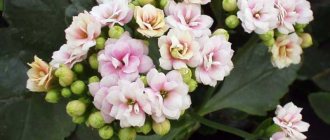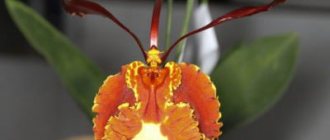Calathea can justifiably be considered the emerald of any flower collection - both among famous florists and ordinary people. But before you grow this tropical flower at home, you need to clearly understand that you will have to care for it sensitively and for a long time.
Dear readers! For you, we have created communities on social networks in which useful articles and interesting ideas are published several times a day! Subscribe and receive useful content in a convenient format!
True, none of the care requirements is impossible. Otherwise, we would be able to see Calathea exclusively in the places of its historical growth (in the tropics and subtropics), or in real pressure chambers maintaining the necessary climate artificially. But this, of course, is far from the case.
Other names for Calathea
The botanical name - Calathea - has become very widespread not only in the scientific community, but also in life.
INTERESTING. The name of this flower comes from the Greek word “calathos”, which literally means “basket”. The fact is that in ancient times baskets were woven from Calathea leaves.
But, perhaps, you can find another equally popular name for this flower. It is often called a prayer tree . Thanks to special pads located in the thickenings of the leaf petioles, Calathea has the ability to turn the foliage according to the movement of the sun.
But the main feature that the ancients noticed and why they dubbed the flower a prayer flower is the ability to lift and join the leaves together before rain or in the evening after sunset.
This action looks as if the flower is folding its leaves-palms in a prayer gesture.
Features of the plant
In Greek, Calathea means "basket". And, indeed, there was a time when bushes were used to make baskets. Nowadays it is mainly grown as an ornamental.
The leaves of the tropical plant surprise with a variety of colors - from white-green to red-brown. They have an oval shape with a geometrically regular pattern. True, each species has its own, not similar to its fellows. The flowering does not look beautiful enough, although there are specimens with rather pretty spike-shaped flowers.
Some of the species have an amazing property: in the evening the leaves are pulled towards each other, reminiscent of hands intertwined before prayer, and when the sun warms up, they return to their original position.
Caring for Calathea after purchasing from a store
To begin with, don’t hesitate - any variety of Calathea will be oh so difficult to care for. But it has been noted for sure - if you have little experience, it is better to start with Kalotea Makoya . It is very common primarily because of its relative unpretentiousness. But Calathea Saffron and Crocata are the most demanding and the most capricious to any little things.
Remember that the biggest and most common problem that causes Calatheas to die is dry air in the apartment. In second place is lack of light or direct sunlight on the flower.
Of course, before purchasing, you need to find a place where there will be the most light during the day. But protect the flower from direct sun with screens or other improvised objects.
You can humidify the air by frequently spraying water near the plant, as well as placing saucers of water for natural evaporation of the liquid. Now that the place is ready, you can buy your first Calathea in the store.
Remember that quarantine is required for this plant. You need to wait 1-2 weeks without taking any action to replant, fertilize, etc. It is even recommended to water Calathea not immediately, but three days after purchase, when the plant has more or less adapted to its new location.
During this quarantine time, it will become clear whether the flower was grown in the store correctly. All possible fungi, infections, diseases and pests in new conditions will immediately make themselves felt.
ON A NOTE. In the future, Calathea will need to be transplanted into completely new soil. To do this, carefully remove the flower with a lump of earth and slowly shake off the soil from the roots. The new container should be selected wider than the previous one by about 5-6 cm.
Possible problems in cultivation and diseases
Problems that most often arise when growing calathea:
- Yellowing and wilting of the lower leaves. Fusarium wilt may be the cause. The disease cannot be treated, so it is better to dispose of the flower.
- Pest infestation. Calathea can be parasitized by aphids, mites, scale insects, and mealybugs. Insecticides will help in the fight against them.
- Rollability of the sheet plate. The reason lies in insufficient hydration. When the leaves begin to curl, it is important to adjust the watering; the soil should remain slightly moist.
- Drying of leaf edges. This problem is caused by very dry air, insufficient lighting, and excess fertilizer. It is recommended to organize proper care.
- The foliage was covered with brown spots. This can cause sunburn or waterlogging of the earthen clod.
In order to have fewer problems with the flower, it is important to simply follow the conditions of agricultural technology and the requirements for growing the crop.
Dry air causes leaves to dry out
Growing conditions
Contrary to what might already seem to the contrary, Calathea is a completely terrestrial plant. Just with your whims and requests. But they are all standard: the right light, precise dosage of watering, maintaining humidity.
Temperature
It is obvious that Calathea prefers warmth, because we remember that it originated from the tropical zone. This means that in summer it needs at least +20°C, and in winter within +15-18°C.
IMPORTANT! Due to the fact that Calathea requires a constant temperature without sudden changes, do not place it in places where there are drafts!
Air humidity
When growing Calathea, you will have to very carefully monitor the air humidity in the room. It is necessary to maintain this indicator from 90%.
Firstly, you will have to put into practice constant spraying of water from a spray bottle - up to 3-4 times a day. Moreover, this is typical for both summer and winter, when the air is strongly dried by working batteries. When spraying water, try to get as little water on the flower itself, its leaves and flowers. Point the sprinkler to the sides.
BY THE WAY , constant spraying can be left in the hands of automation. Today there are many offers for room humidifiers.
Secondly, it is advisable to leave saucers or any other container with water next to the flower. Humidity will be higher due to natural evaporation of liquid.
Lighting
Don't forget about lighting. For Calathea, it is important to observe two points: find the area that is maximally illuminated during the day and protect the flower from direct sunlight.
What kind of pot does a flower need?
In principle, you should not tear the veins, looking for some special dishes for your Calathea. Any container that you can find on the market will do.
Take only one piece of advice: when choosing between a clay and plastic pot, give preference to the second. Clay dishes absorb moisture, which increases the risk of liquid stagnation in the pot, which means putrefactive processes in the roots.
Choosing a place to put a flower pot
Some gardeners easily grow Calathea on windowsills. When choosing this option, it is optimal to give preference to western, eastern or southern windows. There will be as much light as possible during the day. However, the window then needs to be protected from direct sun by a screen. The second point is that it is advisable not to open the window, as drafts will harm this plant.
Most often, Calathea can be found not on window sills, but in specially designated corners of rooms, along passages, and walls. Yes, it is more difficult to organize high-quality lighting there, but there is no need to fence off the plant from the direct sun, and there are less drafts in the corners.
The lack of the same light can be easily circumvented, for example, by artificial supplementary lighting.
What does it look like in the interior?
The most remarkable part of Calathea is its leaves. Then the flowers. The most interesting thing is that the leaves can differ dramatically from variety to variety. But in any case, the plant will harmoniously fit into any existing interior - from a classic solution to the most modern and futuristic. By the way, modern high-tech and modern are also gradually filled with elements of natural decorations, and not artificial ones, as before. Therefore, Calathea will certainly become an effective tool for embodying even a bold design idea.
Water
White Fusion Calathea prefers to be kept moist at all times, but getting wet and waterlogged is a recipe for disaster. These plants love high humidity, but soil that is too wet can lead to root rot and bacterial and fungal diseases. It is also important to ensure good drainage holes in the pot the plant is in.
When the top inch of soil dries out, it's usually a good indicator that your plant will need more water. Shriveled leaves may be a sign that your plant is too dry.
Many enthusiasts prefer to use rain or distilled water for their calathea, but tap water at room temperature will also work. However, it is best to leave it overnight before use to reduce the chance of fluoride toxicity. This is especially true for built-up urban water systems.
Features of care at different times
Calathea does not like sudden changes in light, watering, or temperature. Therefore, it is obvious that in each season you will have to work hard to achieve the ideal appearance of this flower.
in spring
It is advisable to start feeding Calathea in early spring, but no more than 1-2 times a month.
In summer
In summer, it is most important to maintain indoor humidity. Feeding continues. Watering is the most intense, up to 3 times a week.
in autumn
In the fall, stop fertilizing and reduce watering to 1-2 times a week.
in winter
In winter, it is important to organize artificial supplementary lighting, since Calatheas mainly bloom in early spring, and flower stalks are laid in winter.
How to care for calathea at home
Knowledge of the secrets of breeding calathea is necessary for beginning flower growers. The demanding crop requires careful care and special conditions: a certain temperature regime, high humidity. Lighting should be continuous, but not intense.
Lighting and temperature conditions
Calathea grows naturally in the lower tiers of humid equatorial forests. Tall trees greatly shade the place where it grows. This explains the fact that the culture does not like bright light. Direct sunlight leaves burns on its leaves. The flower is more suited to diffused light.
The optimal place for it is the windowsill of windows facing east or west. Calathea feels great under artificial lighting from fluorescent lamps. It can be placed deep into the room, providing illumination on cloudy, winter days. Calathea grows well without sunlight if artificial light is 14-18 hours a day.
Regardless of the location of the flower, it needs 15 hours of daylight. Insufficient light causes the leaves to fade. If no measures are taken, the plant sheds its leaves and dries out. When there is excess sunlight, calathea produces small leaves, which eventually curl into a tube.
The optimal temperature for a tropical plant is 24-28 degrees. Calathea growth slows down in winter, so lowering the temperature to 17-22°C is acceptable. The flower may die if the temperature drops below 15°C. The death of calathea is also provoked by prolonged exposure to a cold draft and a sharp change in air temperature.
Watering
Caring for calathea at home
Caring for calathea at home requires proper watering. In order for the plant to be in excellent condition, the following rules must be followed:
- Water with settled melt or rain water.
- Only warm liquid (25-27°C) can be used to moisten the soil.
- Approximate watering schedule: in summer – 3-4 times a week, in winter – once every 6-8 days.
- An adult calathea requires 0.5-0.7 liters of liquid.
- The crop should be watered only when the top layer of soil has dried.
- Tap water needs to be settled and softened so that harmful impurities of calcium, iron, magnesium do not settle on the roots and violate their integrity. Throw 2 handfuls of peat into a bucket filled with liquid and leave for 2 days. During this time, harmful substances will settle to the bottom, and the chlorine will evaporate. The settled water is filtered and only then used for irrigation.
- You need to water the calathea from a watering can with a narrow spout. Pouring water on the ground. It should not get on the petioles.
Air humidity
Calathea does not tolerate dry air. The optimal air humidity for the crop is 70-80%. Such indicators can only be achieved in a greenhouse. If there is excessive moisture, crop varieties with velvet leaves should absolutely not be sprayed. For other types of calathea, only mist irrigation is permissible - from spraying, the edges of the glossy leaf blades begin to dry out. At home, you can use several techniques to increase air humidity:
- Fill a large deep pan with expanded clay and fill it 1/3 with water. Place sphagnum moss on top. Place the pot of calathea on a tray. Drainage material is able to accumulate moisture and gradually release it. A layer of moss will slow down the process of water evaporation. Sphagnum will protect the roots from contact with liquid, leading to their rotting.
- Install a household humidifier near the calathea.
- Grow the crop in a florarium - a tall vessel with glass (transparent) walls.
- Place a wide plate of hot water near the pot, which evaporates quickly.
- Place calathea among other house flowers, spray their leaves and the air around green spaces.
Fertilizer application
Calathea care includes periodic feeding. It is better to choose liquid complex mineral fertilizers for decorative deciduous crops. It is necessary to select a chemical composition that does not contain calcium and has a low nitrogen content. Fertilizer for arrowroot is ideal for calathea.
Calathea is fed during the active growing season (from March to September). The feeding regime from spring to autumn is once every 2 weeks. In winter, the flower is fertilized once a month (if the leaves begin to fade). Strict adherence to the dosage of fertilizer according to the instructions for use is mandatory. Fertilizer is applied to moist soil half an hour after watering.
Pest Control
Caring for calathea requires wiping the leaves with a damp cloth at least once every 2 weeks and inspecting it carefully. This approach will prevent the accumulation of dust on the foliage and serve as prevention against pest attacks. The sooner parasites are noticed and measures are taken to destroy them, the less calathea will suffer. To prevent pest damage to the crop, dried, yellowed leaves and dry inflorescences should be removed.
If pests are noticed on any plant from your home collection, it must be immediately isolated from the calathea. When there are a large number of parasites, insecticides are used. It is better not to use chemicals in enclosed spaces (apartments, offices, etc.) Description of pests and control methods:
| Name of the pest and signs of damage to calathea | Effective chemicals | Folk ways to get rid of calathea from parasites |
| Mealybug On the petioles of the calathea, in the axils, on the back of the leaf blades, a white coating resembling cotton spools is visible. |
|
|
| Spider mite The smallest insects are visible; red and white spots appear on the foliage; Calathea withers and sheds its leaves. |
|
|
| Shchitovka The plant is covered with small brown growths, under which parasites hide; the leaves become covered with a sticky coating; the foliage becomes deformed and turns yellow; calathea withers. |
| Perform the procedure in the following sequence:
|
| Whitefly If you hit a calathea leaf, small white midges fly up; Insects and their eggs are visible on the reverse side of the leaf blade. |
|
|
Is the plant blooming?
Of course, Calathea is grown not only for its exotic foliage in color and shape, but also for its flowering. The peak of this process occurs in different varieties in different months. But in general, we can say that flowering occurs more often in the cold season, mainly stretching over 1-3 months. Some varieties bloom around January, but most still delight with flowers no earlier than March.
Calathea flowers are small, reaching no more than 5-6 cm in diameter. They are collected in tubular-shaped inflorescences.
The color of the petals is a unique feature of almost any Calathea variety. For example, the mosaic variety blooms with white inflorescences. Saffron Calathea is orange, and Zebrina is lilac or purple. The entire palette of other varieties is truly rich and can really greatly diversify any home garden if you grow several types of this plant at once.
Decorative foliage species of calathea
Calathea Makoya, Calathea arrowroot, Calathea Makoyana
Large calathea, up to 60 cm high, native to Brazil. The leaves are large, oval, silver-green with oblong dark green spots. The bottom of the leaf is purple.
Calathea Makoya
Decorated calathea, or striped calathea, Calathea ornata, Calathea majestica
Quite a tall calathea, from half a meter to a meter high. The lanceolate leaves are decorated with green and pink stripes, and red on the inside.
Flowering Calathea adorned, or Calathea striped
Calathea decorated and
Calathea White Star, or White Star, is a variety characterized by moderate growth rates, reaching a height of 60 cm.
Calathea zebrina
Calathea is up to 70–80 cm high with leaves 30–40 cm long, bright green with brownish-green blurry wide stripes along the lateral veins, velvety, purple below.
Calathea striped
There is a variation of var. humilior, which has softer leaves that are green below.
Calathea lancifolia
Brazilian calathea is 30-60 cm high with lanceolate leaves, colored in various shades of green with small and large oblong-oval dark green spots. The underside of the leaves is purple-red.
Calathea lancefolia
Painted calathea, or painted calathea, Calathea picturata
Calathea with oblong-oval leaves, painted white or yellowish, the edges of the leaves are dark green.
Calathea painted, or painted Argentea - the variety is distinguished by oval silver-colored leaves with a dark green, wavy border.
Redbeard Calathea, Calathea rufibarba
Calathea 30-50 cm high with narrow dark leaves with wavy edges, red underneath.
Calathea redbeard
Calathea orbifolia
Calathea, up to 60 cm high, with wide leaves with clear stripes.
Calathea orbifolia
Rose-colored calathea, Calathea roseopicta
Calathea, up to 80 cm high, with large oval leaves that vary greatly in color: from dark green to bright red. There are varieties with stripes, borders and spots.
Calathea Crimson is a very popular variety with dark pink foliage with a dark border.
Calathea network, or Calathea mosaic, Calathea network, Calathea musaica
A low calathea with an original color that looks like a fine mesh.
Calathea netvor tolerates apartment conditions better than other cultivars; it is not so demanding on humidity and lighting.
Calathea network, or Calathea mosaic
Calathea concinna
A small calathea with green leaves adorned with deeper green patterns reminiscent of a leopard pattern.
Calathea slender
Calathea Fusion White, Fusion White, White Tiger
A collectible, rare species of calathea with beautiful leaves with white stripes. Plant up to 80 cm high.
Calathea Fusion White, Fusion White, White Tiger
In addition to the listed species, other types of calathea can be grown in culture: Calathea pseudoveitchiana, Calathea orbifolia, Calathea insignis.
How to plant a flower?
The optimal time for planting a flower is the off-season, autumn or spring. The action can be timed to coincide with the next Calathea transplant.
The plant is planted quite standardly: they carefully take out the bush along with the earthen lump, and slowly free the roots from the ground. Then the bush is divided into separate parts.
Important:
- So that each sprout has 2-3 leaves of its own.
- So that everyone has a well-developed rhizome.
Parts of a large bush are planted separately from each other. The soil requirements are standard (loose and nutritious), drainage should also be about a third of the height of the pot.
How to replant calathea
The roots of plants of the Marantaceae family release toxic substances into the soil, so frequent replanting can only benefit them. Until the flower reaches 4 years of age, they are carried out every spring, then every 2 years. In addition, calathea purchased in a store requires replanting after purchase from a shipping container into a permanent pot. But before replanting the calathea after purchase, it needs to be left for about a week. During this time, the flower will adapt and get used to the new place.
To replant, you need to prepare a pot and soil for the calathea. If you are in doubt about what kind of pot you need, choose a container that is wide and not too deep, since the root system of calathea is superficial. For the very first pot in which a young seedling is planted, a diameter of 10-12 cm is sufficient. Each subsequent pot should be approximately 4-5 cm larger than the previous one. Calathea absorbs water very well, so you can safely choose a pot without drainage holes.
This flower needs regular replanting, but not pruning. Calathea is never completely pruned. Usually, only yellowed leaves that are about to fall off and dry tips are removed, leaving a thin strip of dry tissue.
The soil for calathea should be light, loose, slightly acidic (pH 5.5-6.5). You can use a substrate for decorative foliage plants from the store or prepare the composition yourself by mixing leaf soil, peat, humus and sand in a ratio of 2:2:2:1 or turf soil, peat and sand in a ratio of 2:1:1. To prevent root rotting, a small amount of charcoal is added to the substrate. You can also take a simpler route - purchase a zeolite-based soil, for example, Zeoflora. It perfectly absorbs nutrients from water and air and gradually, as needed, gives them to the roots. In this case, a drainage layer is not needed.
How to transplant calathea at home without risk:
- A layer of drainage (expanded clay) is poured onto the bottom of the pot, approximately ¼ of its height. Soil is laid on top of the drainage in a layer slightly more than half the height of the pot. Or simply pour a layer of Zeoflora substrate, Zeolite or similar soil.
- Calathea is carefully removed from the old pot along with the earthen lump. The procedure will be easier if you water the flower a few hours before transplanting.
- Using the transfer method, the calathea is placed in the center of the pot (the height of the earthen ball should be approximately 2-3 cm below its edges) and soil for the calathea is poured into the free space around the entire circumference. The growing point must remain above the surface. There is no need to compact the soil; the root system of the calathea must breathe.
- On top you can lay a decorative layer of ceramic shards (2-3 cm in size) or something similar. It will add aesthetics to the entire composition and protect the top layer of soil from erosion and help retain moisture in it longer.
- The transplantation procedure is completed with abundant watering. Subsequently, watering is carried out less abundantly (without flooding), once every 3-5 days if the calathea is planted in a standard substrate or once every 7 days if a zeolite-based substrate is used.
Since calathea is shade-loving, after transplanting it is better to place it not on the window, but at a distance, perhaps even in the back of the room. This way it will better adapt to the new pot and soil. This flower does not need regular pruning. You just need to take care of the timely removal of heavily damaged and dried leaves.
Reproduction in different ways
There are several ways to propagate Calathea:
- The most commonly used is by dividing the bush. It requires a healthy bush, which is taken out of the pot, completely freed from the soil and divided into new bushes with their own root system.
- Cuttings - a stem with a growing point and at least 3-4 leaves is selected for it. Plant the cuttings in sand and peat soil, maintaining high humidity for rooting.
- By seeds - a complex method that requires a lot of time. Plant the seeds in early spring, lightly pressing them into the ground. The container is covered with film or glass and ventilated daily. You can transplant the sprouts to a permanent place only when they have formed at least 3 of their own leaves.
How does calathea reproduce?
Before propagating calathea at home, you will have to decide which of all the possible options is best for you. Calathea propagates in four ways: by dividing roots, leaves, cuttings, and seeds.
Root division
This is the most effective and fastest way to plant calathea at home. Flower growers use it most often and practice it together with transplantation. Calathea forms rhizomes and nodules. In adulthood, the rhizome branches and is easily divided.
Procedure:
- The flower is taken out of the pot along with the earthen lump and carefully divided into 2-3 copies, trying to damage the roots as little as possible. For disinfection, the roots of the separated parts are sprinkled with crushed charcoal.
- The delenki are planted in pre-prepared pots filled with peat and coarse river sand in a ratio of 2:1 and watered generously with warm, settled water.
- Each pot is placed in a plastic bag and placed in a warm place. The bags with the cuttings are tied, but loosely, so that air can penetrate inside, or holes are made in them.
- When 1-2 new leaves appear on the calatheas, they are transplanted into permanent pots.
Propagation of calathea by leaf
This method is not as popular as division, but it is simpler and also gives good results. For propagation, you need to choose a healthy young leaf that is not too large. Otherwise, the procedure is exactly the same as when dividing roots:
- A suitable leaf is carefully separated from the flower, so that the growth points remain on it and on the mother plant.
- Plant in a pre-prepared pot with wet soil, place in a plastic bag and place in a warm place.
- When the seedling takes root, it is transplanted into a permanent container.
Cuttings
Propagation by cuttings is a method similar to the previous one, but a little more labor-intensive. A cutting with a stem length of at least 15 cm with 3-4 leaves is separated from the mother plant, making sure that it has a growing point, and planted in a pot with moist soil. Then the pot with the cutting is placed in a plastic bag with holes for air and left to take root in a warm place. After the appearance of several strong roots, it is planted in permanent soil.
Propagation by seeds
Growing calathea from seeds is the most unpopular and labor-intensive method of propagation. Even under ideal conditions, no more than half of the seeds germinate. In addition, this method is unpredictable, since in 99% of cases the specific features of the calathea are lost, its color may be the most unexpected. It is usually used by flower growers who like to experiment.
Seeds are collected from an adult flower in the fall, when the flower stalks are completely dry. Considering that calathea blooms very reluctantly at home, a more reliable option is to purchase ready-made seeds in the store. During the day, for greater germination, they are soaked in warm, settled water, and then sown, without deepening, in a shallow container filled with wet zeolite or a mixture of turf soil with river sand in a 2:1 ratio. To create greenhouse conditions, the container is covered with plastic film, which is removed every day for 2-3 hours for ventilation. The optimal air temperature for germination is + 22–25 ºС. After the sprouts produce the first pair of true leaves, they are planted in small pots (6-8 cm in diameter).
Diseases and pests
A capricious tropical flower withers if not properly cared for, and in the worst case, gets sick and suffers from pests.
In principle, most of Calathea's problems are associated with either excessively dry air or high humidity.
- So, spider mites easily grow on dry soil. The damage they cause is considerable - Calathea leaves, the main element of decoration, dry out.
- Scale insects are small insects that feed on Calathea juice. It is difficult to notice them, because they hide on the back of the leaves. But the plant suffers greatly - the leaves first turn white, and then dry out and fall off.
- If entire holes begin to appear in the leaves, then most likely the flower has been infected by Thrips.
- Of the diseases, Calathea is most often susceptible to fungal infections. This is due to high humidity or stagnation of liquid in the pot. The most dangerous situations are when the flower is affected by root rot (the stem turns black near the ground). In this case, there is very little chance of saving the plant.
Get rid of pests using purchased products according to the instructions. But preventive treatments against insects can also be carried out using traditional methods - for example, spraying bushes with a weak solution of hydrogen peroxide up to 3 times a day.
Why do Calathea leaves dry out?
Leaves are the main decoration of Calathea. That’s why most gardeners worry about situations when they don’t look very good. Meanwhile, the reasons for this phenomenon often lie on the surface:
- The leaves wrinkled, drooped, and began to dry out - the reason lies in the dryness of the air.
- The leaf blades curl or become covered with pale yellow spots - they get a lot of sunlight.
- If the cuttings stretch out too much, this means there is not enough light.
- Brown or even black spots on the glossy surface of the leaf - reduce watering.
- Leaves droop and become lethargic with frequent temperature changes or drafts.
Beautiful flowering species of calathea
Saffron Calathea, Calathea crocata
The most famous calathea, but rather capricious.
This calathea is low, up to 40 cm. The leaves are dark green, slightly pubescent. During the flowering period, orange spikes of inflorescences rise above the foliage.
Blooming Calathea saffron
Requirements for growing Calathea saffron
For growth and flowering, a bright place with high air humidity is necessary; if the air is too dry, the saffron calathea can shed its leaves. In winter, it is useful to place a humidifier next to the calathea.
Calathea warschewizii
Quite a large and VERY beautiful calathea with large, velvety, dark green leaves. The undersides of the leaves are dark purple.
Flowering of Calathea Varshevich. Flowering shoots sometimes need support.
How to resuscitate?
As a rule, it is possible to improve the health of Calathea as soon as a more suitable place is found. But we also don’t recommend moving the flower pot back and forth too often - for such a capricious plant it will be stressful, which will certainly lead to disease.
But it is more difficult to fight diseases or pests. It is better to use purchased drugs and not deviate one step from the manufacturer’s instructions.
Light
Proper light is one of the most important elements of caring for your Calathea 'White Fusion'. If this is not the case, the variegation on the plant will not develop properly. Filtered bright light is what you need. Too much light can cause the markings to fade and the leaves to curl, and an area that is too shady and the markings will not develop properly.
Avoid south-facing locations that often receive intense direct sunlight. Windows facing east, west or north usually work well. Or you can diffuse the bright light with a sheer curtain.
Answers to popular questions
Where to put the pot with Calathea?
It is best to place it on the floor, near the walls, away from radiators. You can place the flower on the windowsill (west, east or even south), but then you will have to protect it from direct sunlight.
When does the plant bloom?
This usually occurs in early spring and ends around early summer.
Can I leave it while on vacation?
Actually, no. Irregular watering, unstable humidity and temperature changes are the first step to disease and imperfect appearance.
Signs and superstitions
Why is the culture so popular among gardeners? Calathea is a symbol of happiness created by family. The plant is able to bring calm and peace to the house, as it can absorb negative energy. The culture is considered one of the best house flowers. This is a shield that protects against the evil eye, gives love, joy and peace, helps to become stronger, and achieve success in any endeavor.
Calathea, caring for which at home will not be difficult even for a novice gardener, is presented in a huge assortment of species. Therefore, choosing the right variety will not be difficult. The main thing is to monitor the condition of the flower and organize comfortable conditions for it in a timely manner. In return for your care and attention, the plant will delight you with its beauty and help you create spectacular compositions for the interior.
Conclusion
An amazingly beautiful flower, as if endowed with magical qualities, is Calathea, a well-known flower among domestic gardeners. True, despite its exotic, inimitable beauty, which can elevate absolutely any flower garden to a new level, the plant has become famous as incredibly sensitive to care. Even not all experienced flower growers really cope with it.
Of course, we recommend not to overestimate your strengths, but to carefully prepare for choosing a variety, and then caring for Calathea. And you have already taken the first step towards this by reading our article.
For our part, we wish you good luck, because a well-groomed and fragrant Calathea in your greenhouse will certainly become a kind of order, evidence of your professional success in floriculture!
Calathea in the house: benefit or harm?
This exotic flower is capable of purifying the air by 10% of formaldehyde in the air . In addition, the plant has a calming effect, it is especially useful for people suffering from insomnia.
According to Chinese scientists, this flower can protect a person from colds because it has special energy and warms the body. Calathea promotes the resorption of blood clots .
It is believed that this plant helps in trade and personal life. Timid people gain confidence and inner strength next to him.
It is especially recommended to grow this flower in houses with a lot of people, as it absorbs aggression and irritability of household members and helps to find compromises in disputes.
Prominent representatives of Calathea: Rufibarba, Zebrina, Lansifolia, Medallion and Makoya.











